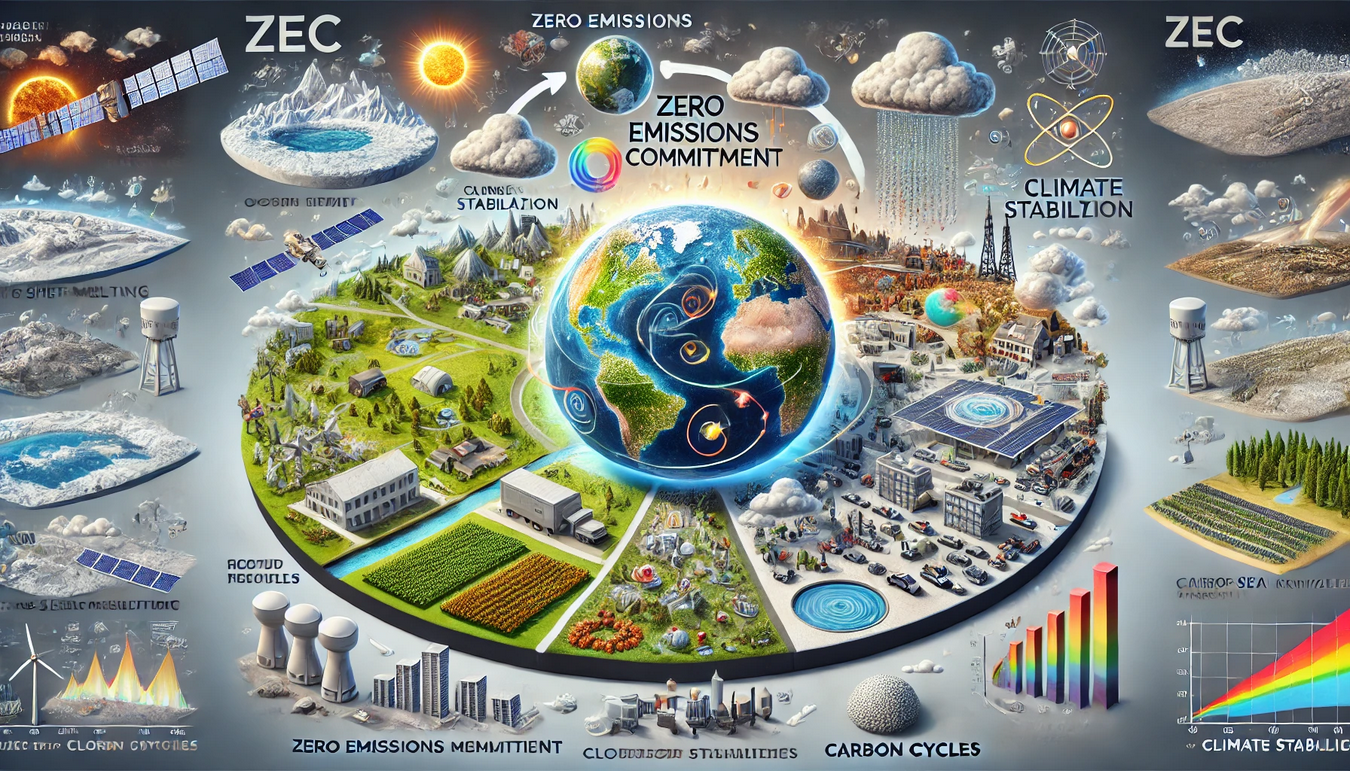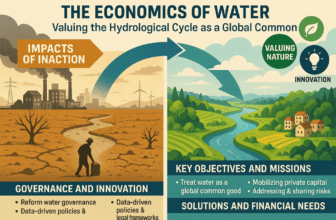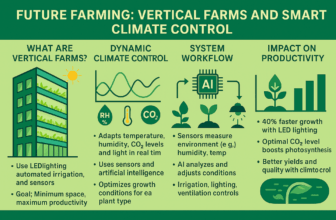Understanding Zero Emissions Commitment: Key Objectives, Challenges, and Required Investments for Climate Stabilization

Climate change is one of the most complex challenges of our time, requiring comprehensive solutions from both science and policy. Addressing climate change involves understanding intricate processes, reducing uncertainties, and implementing effective mitigation measures. A key concept in managing climate change is the Zero Emissions Commitment (ZEC), which refers to changes in global surface temperature after anthropogenic CO2 emissions reach net zero. The document “Zero Emissions Commitment and Climate Stabilization” delves into the definition of ZEC, its implications for climate stabilization, associated uncertainties, and the necessary investments in scientific research and policy measures.
Objectives
The document identifies four main objectives:
- Understanding ZEC and Its Impact on Climate Stabilization: One of the key objectives is to define and analyze ZEC to determine if and how global temperatures stabilize after emissions are reduced to zero. This involves examining the complex system processes that play a role in temperature stabilization, including feedback mechanisms, carbon sinks, and other interacting components of the Earth system. Understanding ZEC is crucial to determining the effectiveness of emission reduction strategies and ensuring that global temperatures do not continue to rise after reaching net zero emissions.
- Analyzing Uncertainties of ZEC and Their Impact on Policy: Another critical objective is to examine the uncertainties associated with ZEC and their implications for climate policy. These uncertainties include the influence of Earth system feedback, such as permafrost thawing and ocean heat uptake, which can significantly affect ZEC outcomes. By understanding these uncertainties, policymakers can better anticipate potential risks and develop strategies to mitigate their economic and political consequences. This analysis also involves exploring how different models interpret these uncertainties and what measures can be taken to minimize the associated risks.
- Mapping Future Research Directions: The document aims to provide guidance for future research that will improve our understanding of ZEC, reduce associated uncertainties, and refine the models and measurements used in climate science. This includes identifying specific research areas, such as high-resolution climate modeling, long-term observational studies, and interdisciplinary research efforts that combine climate science, ecology, and socioeconomics. The ultimate goal is to create more reliable models that can predict ZEC outcomes with greater accuracy and provide a robust foundation for climate policy and decision-making.
- Raising Awareness of ZEC’s Importance: A significant objective of the document is to raise awareness among scientists, policymakers, and the general public about the importance of ZEC in the context of climate mitigation and stabilization. Effective communication is essential to convey the significance of ZEC and ensure that stakeholders understand its implications for long-term climate goals. Raising awareness also involves emphasizing the need for timely action, as delaying mitigation efforts could result in more significant challenges in stabilizing global temperatures in the future.
Key Inconsistencies and Uncertainties
The document highlights several critical inconsistencies and uncertainties affecting ZEC, which are essential to address for better climate projections and policy decisions:
- Interdependent System Effects: Current models inadequately represent the complex interactions between various Earth system processes, such as ice sheet melting, ocean circulation, and carbon absorption. These interdependent effects can lead to significant uncertainties in ZEC estimates. For instance, ice sheet melting affects ocean density and salinity, which in turn influences ocean circulation patterns and the ability of the ocean to absorb carbon. These processes are interconnected, and their combined effects are challenging to accurately simulate, resulting in significant variability in ZEC predictions.
- Temporal Dependence of Cloud Feedback: Cloud feedback plays a crucial role in regulating Earth’s energy balance, but its effect on ZEC remains uncertain. The impact of cloud feedback on ZEC largely depends on sea surface temperature (SST) patterns and the climate state at the time emissions are reduced. The temporal dependence of cloud behavior adds another layer of complexity, as changes in cloud cover and type can either amplify or dampen warming. Current models struggle to capture the temporal dynamics of cloud feedback accurately, which leads to uncertainties in how clouds will influence ZEC.
- Complexity of Carbon Cycles: The dynamics of carbon cycles, particularly after the cessation of anthropogenic emissions, introduce additional uncertainties to ZEC predictions. Soil carbon loss, vegetation distribution changes, and the response of ecosystems to a changing climate are all factors that can continue to affect atmospheric CO2 levels long after emissions have ceased. These changes can either enhance or reduce carbon sequestration, impacting ZEC outcomes. Additionally, disturbances such as wildfires, pest outbreaks, and droughts can alter carbon storage in forests and soils, adding further uncertainty.
- Model Limitations and Emission Scenarios: Many ZEC estimates are based on idealized emission scenarios that do not fully account for actual historical or potential future land-use changes. These models may underestimate or overestimate carbon emissions or carbon sequestration potential depending on specific land-use histories and future developments. For instance, deforestation, reforestation, and changes in agricultural practices can all significantly impact the carbon balance. The lack of detailed land-use modeling limits the accuracy of ZEC estimates and complicates efforts to create effective climate policies.
- Non-linear Climate and Biological Responses: Non-linear responses to climate change add considerable uncertainty to ZEC predictions. Processes such as the response of high-altitude clouds to warming, biological reactions to ocean acidification, and shifts in ecosystem dynamics are not directly proportional to temperature changes. These non-linearities mean that small changes in one part of the system can have disproportionate impacts elsewhere, making it difficult to predict outcomes accurately. For example, warming can lead to abrupt changes in ecosystem states, such as the collapse of coral reefs or the transition of forests to savannas, which have significant implications for carbon storage and climate stabilization.
Estimated Investments
The document outlines significant investments needed to address the identified inconsistencies and reduce uncertainties associated with ZEC:
- System Effects:
- Computational Power and High-Resolution Models: Developing and utilizing new supercomputers and advanced simulation software capable of modeling complex interactions more accurately would require an estimated investment of €50–100 million per year. These models are essential for simulating the detailed interactions between Earth system components and reducing uncertainties in ZEC estimates.
- International Research and Collaborative Projects: Additional international collaborative projects and research initiatives would be necessary to pool knowledge and resources, estimated at around €10–20 million per year. Collaboration allows for more comprehensive studies and improves model validation across different regions and conditions.
- Cloud Feedback:
- Satellite Missions and Long-Term Observations: Funding for additional satellite missions and ground-based observations to gather long-term data on cloud feedback could require investments of approximately €200–300 million over the next decade. This data is crucial for understanding the role of clouds in the climate system and improving the accuracy of ZEC predictions.
- Improving Climate Models: Investments in refining climate models to better simulate cloud feedback could range from €30–50 million per year. Enhanced models would help capture the complex interactions between clouds, SST, and atmospheric dynamics, reducing the uncertainty associated with cloud feedback on ZEC.
- Carbon Cycles:
- Long-Term Ecosystem Studies and Observation Networks: To better understand soil and vegetation dynamics, investments in long-term observational studies and ecosystem monitoring networks are needed, estimated at €20–40 million per year. These studies would provide valuable insights into how ecosystems respond to changing climate conditions and how these responses impact carbon storage.
- Development and Validation of Modeling Methods: Developing new and improved models that account for complex carbon cycles and their long-term impacts would require an additional investment of €10–20 million per year. These models are crucial for accurately representing the feedback between the biosphere and atmosphere in ZEC estimates.
- Emission Scenarios and Model Limitations:
- Developing More Accurate Land-Use Models and Scenarios: New research and models that consider various land-use scenarios could demand additional investments of €15–25 million per year. These models would help capture the effects of land-use changes on carbon emissions and sequestration, providing a more realistic basis for ZEC estimates.
- Interdisciplinary Research: Engaging different scientific disciplines and fostering collaborative projects to understand and predict the impact of land-use changes on carbon cycles and climate would require investments of €10–15 million per year. Interdisciplinary research helps bridge gaps between fields such as ecology, agriculture, and climate science, providing a more holistic understanding of ZEC.
- Non-linear Climate and Biological Responses:
- Laboratory and Field Experiments: To better understand the non-linearities in biological and physical processes, laboratory and field experiments could require investments of €5–10 million per year. These experiments are essential for identifying thresholds and tipping points in the climate system, which can have significant implications for ZEC.
- Geopolitical Studies and Model Enhancement: Developing enhanced models and conducting studies to better simulate non-linear processes and their effects would require an additional investment of €15–20 million per year. These efforts would improve our ability to predict abrupt changes and non-linear responses in the climate system, which are critical for ZEC.
Conclusion
The document “Zero Emissions Commitment and Climate Stabilization” emphasizes that substantial scientific research and international collaboration are required for an accurate definition of ZEC and for achieving climate stabilization. Understanding the complexities of various Earth system processes and their interdependent effects, as well as accounting for non-linear responses, is critical for improving ZEC predictions. The estimated total investment needed to achieve these goals could reach €300–500 million per year, encompassing additional research, satellite missions, long-term observations, and enhancements to climate models. These investments are essential to reduce uncertainties in ZEC predictions and support more effective climate policies in the future, helping to achieve long-term climate stability and keep global warming at manageable levels.
Achieving climate stabilization will require not only technological and scientific advancements but also strong political will and public support. Effective communication of the importance of ZEC and its implications for climate action is key to mobilizing resources and encouraging timely, coordinated efforts. By addressing the uncertainties and investing in the necessary research and infrastructure, we can improve our understanding of ZEC and enhance our ability to manage the long-term impacts of climate change. These efforts will ultimately contribute to a sustainable future, where global temperatures are stabilized, and the risks of climate change are minimized.









